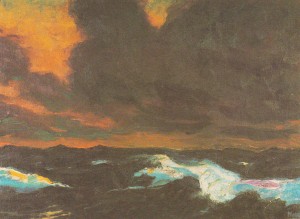 The Die Brucke group of Painters.
The Die Brucke group of Painters.
In a working class area of Dresden, Germany in 1905, a group of ex-architecture students got together to form a community of painters, rather in the way that the Guilds of The Middle Ages operated. Members of the group were Heckel, Kirchner, Pechstein, Schmidt-Rottluuf and for a short time Emil Nolde.
Emil Nolde 1867-1956, soon left the group to go travelling around Europe, he preferred solitude to work on his paintings, they show an integrated vision of the world, that celebrated a love of nature and all that was around him?
In 1930 he painted a series of paintings which he named The Sea. He worked on the island of Sylt, Germany. He wrote, ‘I had a wish to live and paint as alone as possible, only observing and in particular, I wanted to see the sea again, in all it’s wild greatness. His work portrays a savage wildness.
I love to paint the sea, aware of its constant ebb and flow, with huge skies that tower above, often filled with ever changing cloud patterns.
These painters have influenced future paintings in many ways, for example Expressionist painters in the 20th.century, such as Edvard Munch, who painted The Scream and The Sick Child. He wrote ‘there must be living beings painted, who breathe and feel and love and suffer’. His work displays these emotions. Violent distortion and execution of colour were used to express deep or violent emotions – not simply painting what the eye can see.
I wonder if these paintings absorb such emotions, neutralise them? Robert Ellis writes: ‘integration needs to be described in terms of psychological states, rather than just in terms of philosophical analysis of meaning’.
I would welcome your views please.

